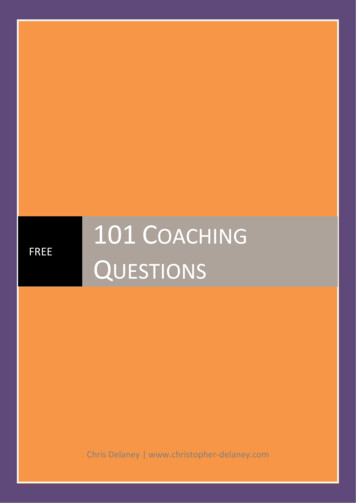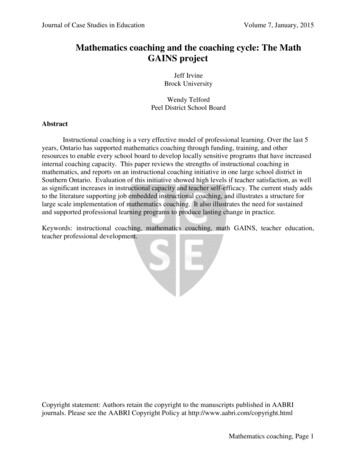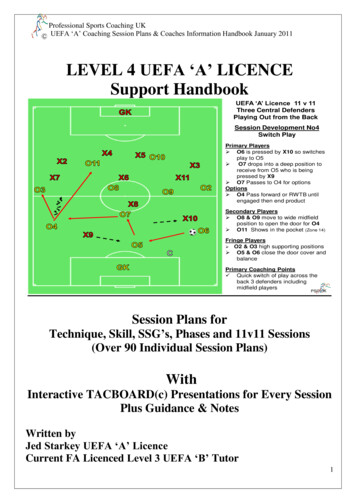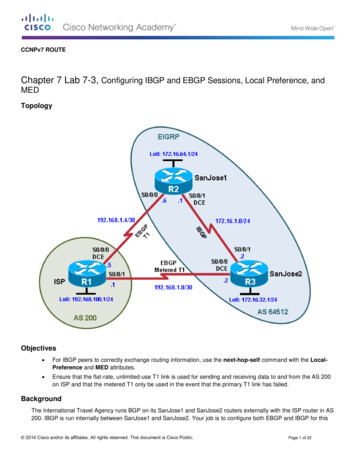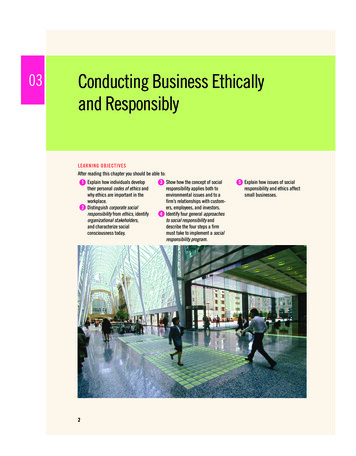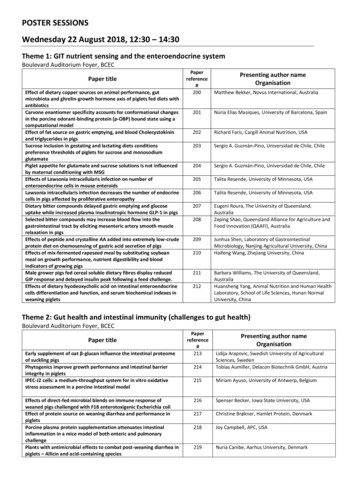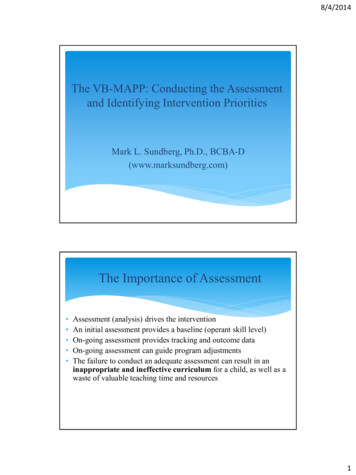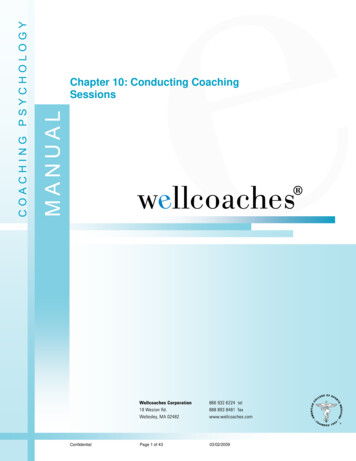
Transcription
Chapter 10: Conducting CoachingSessionsConfidentialPage 1 of 4303/02/2009
Chapter 10Conducting Coaching Sessions“Good fortune is what happens when opportunity meets with planning.”— Thomas Alva EdisonChapter Contributors: Margaret Moore, Erika Jackson, Bob TschannenMoran, and Gloria SilverioAfter reading this chapter, you will be able to: Identify and discuss the guidelines to follow during an initial 45-90 minutevision and planning coaching session Outline the Coaching Contract Use the Coaching Vision Tool to assist clients to develop their wellness,fitness, or health visions Identify and discuss the guidelines to follow during a weekly 20-45 minutecoaching session Identify expectations for the first three months of coaching Demonstrate how to document first session notes Demonstrate how to document subsequent session notesConfidentialPage 2 of 4303/02/2009
INTRODUCTIONAmong the ICF Core Coaching Competencies is “Managing Progress andAccountability” (see Chapter 2), enabling clients to move from Point A, wherethey are today, to Point B, where they want to go. There are many approaches tothe design and process of coaching programs and sessions that facilitatemovement to Point B. Wellcoaches has developed, practiced, and refined overmany years a structure for coaching sessions which has proven highly effectiveand provides a valuable hand-rail for new coaches. There is never only one wayin coaching, yet clients, not just coaches, enjoy structure as a means to gainmastery in change. As coaches gain experience, they can modify the process ofcoaching sessions in ways that maintain engagement for themselves and theirclients.STEP-BY-STEP GUIDELINES FOR THE FIRST 45-90MINUTE COACHING SESSION (CREATING A VISION,THREE-MONTH GOALS, AND FIRST-WEEK GOALS)As discussed in Chapter 8, the initial coaching session sets the tone for the entirecoaching relationship both by establishing trust and rapport and by creating thevision and goals a client will work on for weeks and months to come. Because theinitial coaching session carries so much weight and covers so much ground, ittakes longer than subsequent coaching sessions and may last for as long as 90ConfidentialPage 3 of 4303/02/2009
minutes. It can also be broken up into two 40 minute sessions. The checklist inFigure 10.1 identifies the flow of an initial coaching session.FIGURE 10.1 – Initial Coaching Session Checklist ActionBEFORE THE SESSIONReview the Assessment: Seek out success, notice areas with heightened arousal,consider stages of change, question gaps, note concernsPractice MindfulnessRemember to use the key coaching skills: Mindful Listening, Inquiry and ReflectionFormulate initial, strengths-based inquiriesSESSION OPENINGWelcome and thank youThank client for completing an assessmentIntroduction of Coach: Share personal passion, credentials, and experience if notalready completed in a prior consultationReview and get agreement on the Session Agenda: confirm client expectations andpriorities, gather additional information, create vision, design goalsEXPECTATION SETTING (if not done in a prior consultation)What is coachingConfidentialityRecord keepingEstablish Coaching ContractDISCUSS ASSESSMENTFind something positive to share from the client’s assessmentAsk client what s/he learned about him/herself by completing the assessmentAsk client what questions s/he has after completing the assessmentGather missing informationDiscuss client's medical history and need for physician release, if applicableCREATE A VISIONExplain the value of creating a visionAsk what is most important to the client right nowCollaborate to identify the client strengths: Review success stories, discuss what isworking now, discover what gives the client prideDiscover the client's motivators: ask about the benefits of making changes now, askabout the driving force behind the desire to change nowConfidentialPage 4 of 4303/02/2009
ActionAsk about the client's vision (hopes, wishes and dreams) for health, fitness, orwellnessSupport the client in visualizing his/her vision and describing it in detailUse confidence ruler to assess and improve self-efficacyAsk what challenges would be met and what things would be possible if the visionwere a realityDiscover previous positive experiences with elements of the visionIdentify the strengths and values that could be used to reach the visionExplore the support (people, resources, systems, and environments) needed toensure success and handle challengesAsk the client to state and commit to the visionDESIGN THREE-MONTH GOALSExplain the nature and value of setting three-month goalsBrainstorm consistent behaviors that would lead to the achievement of the visionAsk the client to choose several behavioral goals that are most important to pursueConfirm the connection of the behaviors to the visionAssist the client in developing SMART behavioral goalsDESIGN FIRST WEEK'S GOALSAsk the client to choose goals that are important next steps toward three monthbehavioral goalsAssist the client in designing SMART behavioral goalsUse confidence ruler to improve the client's confidence in reaching the goalExplore the client’s strengths and support (people, resources, systems, andenvironments) needed to ensure success and handle challengesAsk the client to restate and commit to SMART goalsAffirm the client's ability to achieve the goalsSESSION CLOSEExpress appreciation for the client's workDiscover and reflect what the client learnedConfirm that the client is ready, confident, and committed to take agreed upon actions.Ask for feedback on how future coaching sessions would best support the client's pathClarify expectations regarding payments, scheduling, rescheduling, and length ofsessionsSchedule the next sessionConfidentialPage 5 of 4303/02/2009
SECTION-BY-SECTION CONSIDERATIONSThe initial planning session is the most important session in the coachingprocess. Your client will form a “first impression” which will be lasting.BEFORE THE SESSIONGet yourself into the right mindsetThe most important minute of a coaching session is arguably the minute rightbefore it starts. That’s when coaches and clients clear their minds, set theirintentions, and get into the coaching mindset.Relaxation exercises can assist coaches to be completely present and clientfocused.Before the session, remind yourself of these key points: Confidence is contagious. The more we communicate our certainty thatclients can be successful, the more likely it is that clients will be successful.“What do I believe is possible, now?” What we appreciate, appreciates. The more we focus on what clients want,rather than on what they don’t want, the more energy and ideas clients willhave for moving forward. “What do I want to appreciate, now?” Listen until I don’t exist. The more we set aside our own agenda, in favor oflistening for the client’s agenda, the more clients will discover aboutthemselves and discern their own answers. “What do I want to listen for,now?”ConfidentialPage 6 of 4303/02/2009
Tell the truth. The more we reveal clients to themselves, through empathyand honesty, the more progress they will make toward their vision. Don’t beafraid to share what it is there. “How do I want to connect, now?” Trust my intuition. The more deeply we listen to our own instincts andinklings during coaching conversations, the more deeply clients will connectwith their instincts and inklings. That’s what leads to the intuitive dance ofcoaching. “What is my gut saying, now?”SESSION OPENINGEstablish Trust & RapportIt is important to make clients feel comfortable at the outset. Be friendly, warm,respectful, confident, and purposeful. Thank your clients for the privilege of beingtheir coach and for the time they took to complete any pre-session assessments.Express confidence in their ability to reach desired goals and your ability to helpthem. Ask a few basic, “get-to-know-you” questions such as occupation, family,hobbies, physical activities they enjoyed as a child, or daily routine. Find an areaof commonality, if you can, and mention it. Express empathy if clients appearuncomfortable. The key is to create a relational space in which trust and rapportcan grow. Until that happens, the results of inquiry will be superficial and thepotential of coaching to generate transformational change will not be realized.Introduce YourselfBriefly share with clients your biography, if you haven’t already done so. Avoidtalking too long or too much about yourself. Ask whether they have any questionsabout your background. Before beginning the coaching session, ask: "What moredo you want to know about me before we begin?"ConfidentialPage 7 of 4303/02/2009
When introducing yourself, convey your passion to your client, as well asdescribe your education and experience. Be sure to speak from your heart, ratherthan read from a paper. Clients can tell when you are reciting lines, and it doesnot sound genuine.Describe your Objectives for the First Coaching SessionThe first session is an opportunity to gain a good understanding of your client’shistory, strengths, and goals, as well as to build a vision and plan. Explain toclients that your objectives for the first coaching session are:a) to learn more about their priorities, strengths, goals, motivators,challenges, and resources; andb) to help them develop a plan, including a vision, three-month behavioralgoals, and several first-week goals.Have your clients confirm that this is acceptable, and address any additionalquestions or concerns they may have.EXPECTATION SETTINGDescribe the Coach ApproachExplain briefly to your client the difference betweenteaching and coaching. Whereas teachers haveinformation, expertise, and wisdom that they want toshare with their students, coaches enable clients toBeginning with the firstsession, it is crucial thatclients realize they arenot getting a cookiecutter approach.discover a lot of that for themselves. On occasion and when appropriate, coachesmay provide expert advice or knowledge during a coaching session. Most of thetime, however, coaches will listen, ask questions, and reflect back what they areConfidentialPage 8 of 4303/02/2009
hearing in ways that promote client learning, growth, and movement. That is thecoach approach: it’s a personalized learning system which enables people to findtheir own answers and to achieve exceptional results even in the face ofchallenges. Share your confidence that this approach often assists clients toreach higher than they would otherwise.Explain to clients your policies regarding confidentiality and record keeping.Assure them that coaches respect the client’s right to privacy and arefundamentally prudent in the protection of those rights (within the limits ofinstitutional regulations and/or the law). This extends to those records created,stored, accessed, transferred, and disposed of by coaches in the course ofworking with clients.The Coaching ContractIt is important for coaches and clients to agree and commit to some key principlesfor coaching programs before or during the first coaching session. Coachesdescribe this agreement and commitment as a “Coaching Contract”. Items thatmay be included in a Coaching Contract include the following:Coach: Through the coaching process, I will enable my clients to identify theirvision and plan. I will listen to my clients attentively and without judgment or considerationof my own agenda. I will help my clients identify and fully engage their strengths on the path toa better futureConfidentialPage 9 of 4303/02/2009
I will ask questions and encourage my clients to arrive at their ownanswers. I will encourage realistic expectations and goals. I will be direct and firm with feedback when needed. I will assist my clients to brainstorm creative possibilities for movingforward and getting around roadblocks. When appropriate and with permission, I will offer advice and instructionfor engineering fitness, good nutrition, and management of weight, stress,mindset, and health in my client’s life. I will be punctual and responsive. I will recognize early whether the chemistry with a client is good or notoptimal. If not optimal, I will refer that client to another coach. I will acknowledge when my clients have an issue that is outside my scopeof knowledge and skill, and recommend other avenues.Client: I want to improve my level of health, fitness, or wellness. I am ready to take responsibility to make and sustain changes in at leastone area. I am ready to invest at least three months to make improvements. I will be open and honest, and I will share personal information that isrelevant to health and wellness. I am ready to become more self-aware. I am open to suggestions and trying new things. I understand that setbacks are normal on the path of change andnecessary in order to establish new behaviors. I will be punctual and responsive.ConfidentialPage 10 of 4303/02/2009
DISCUSS ASSESSMENTEven though you have carefully read through the information provided in theassessment, you will want to get further clarification and/or additional informationduring the initial session. New things always come out in coaching conversations.As explained in detail in Chapter 7, inform clients that you have reviewed theirassessment ahead of time, giving you a sense of where they are at right now andof what they want to work on. Explain, however, that assessments never tell thewhole story and that it would assist you tocoach them if they would be willing toshare what the assessment surfaced forthem and where they want to go with it.Ask specific questions to clarify missingClients may not reveal criticalinformation to you immediately. Youmay have to build trust in thecoaching relationship before theyfeel comfortable enough to sharekey information.information and to bolster the self-confidence of the client. Remember to seek outsuccesses, to notice the client’s emotional charge (see Chapter 9), to identify theclient’s readiness to change, and to note concerns that may relate to physical ormental health risks.When clients talk about “failures” or things that have not worked for them in thepast, assist them to reframe those experiences as learning opportunities and lifelessons. We grow through “trial and correction,” not “trial and error.” By taking thisnon-judgmental, growth-oriented framework, coaches create a safe place inwhich clients can open up and say anything. Whenever possible, champion theircapacity to change and assist them to find compelling reasons to try again.Curiosity on the part of the coach empowers clients to find their own answers, tobe more resourceful, and to discover new possibilities for moving forward.Curiosity is not interrogation; it is rather an open, inviting, judgment-free,ConfidentialPage 11 of 4303/02/2009
leisurely, and even playful exploration of opportunities for learning and growth. Bydemonstrating curiosity with your clients, you may enable them to become morecurious about their own capacities and more willing to try new things.To use curiosity well, ask deep, open-ended questions that take thought toanswer and that connect clients with their heartfelt dreams and desires. Suchquestions often reveal information that would not otherwise come to the surface.Notice the energy shifts in your clients’ responses. Be curious when your radarpicks up a change in affect, whether that’s increased energy for or resistance tochange. Avoid responding to these questions with analytical questions. Forexample, if a client says, "I want to lose weight," or "I need to get in shape," youmight say, "Tell me about what makes that important to you," or “Tell me aboutwhat that would make possible for you.” Such curiosity is likely to elicit moreinformation than "Why do you want to do that?" because analytical “Why”questions can sound challenging or judgmental.Questions that you may want to ask to confirm an assessment, organized byarea, include:Personal You mentioned that you have children/grandchildren. Tell me about them. What brought you to engage a coach? What would be different in your life if you felt healthier and fit? How supportive would your family be if you wanted to make somechanges?Fitness What fitness activities did you like in the past?ConfidentialPage 12 of 4303/02/2009
What fitness level do you want to attain? What fitness activities can you see yourself doing? What exercise did you do last week? How often? How long was eachsession? At what intensity? I noticed from your assessment that you hate exercise. Tell me about that. Apparently healthy: Would you be interested in some fitness tests you cando yourself to learn your starting point (baseline)?Nutrition What healthy eating habits do you have now? What changes would you like to make in your eating? How do you feel about your eating right now? What eating habits would you like to improve? What foods do you crave? Would you be willing to keep an eating log? How much water do you drink a day? What other fluids do you drink?Weight management When have you been the most successful at managing your weight?Describe your experience and the circumstances. You said you weigh “X” now, and you’d like to weigh “Y.” What would thatchange make possible? You noted that you want to lose “X” number of pounds. Tell me about yourpast experiences with weight management. What has worked in the past? What hasn't worked in the past? How much did you lose? Regain? What have you learned from your past efforts in managing weight thatwould be helpful in the future?ConfidentialPage 13 of 4303/02/2009
Stress On a scale of 0 to 5, 5 being the highest, what is your stress level mostdays? What would assist you to bring that number down? When is your stress at its lowest? What causes you the most stress? What works best for you when it comes to managing stress? What do you do when you're under stress? What have you tried in the past to reduce stress that would be helpful in thefuture?Energy How would you describe your daily energy level? What fills your cup and gives you energy? What empties your cup and drains your energy?Health issues When was the last time you were examined by a physician? How are you feeling today? You noted your cholesterol is high. How high is it? What has your physicianrecommended? What have you done so far to reduce your cholesterol? I see from your questionnaire that you have “X” [name of condition]. Areyou seeing a doctor for this? How is it being treated?Life issues How satisfied are you with your life? Do you generally feel gratitude for your life and relationships? How do youexpress that?ConfidentialPage 14 of 4303/02/2009
How have you cultivated a sense of purpose, or meaning for your life?IMPORTANTNote: A physician’s clearance (if required) and medical data should be collectedin a physical during the first month of coaching to provide baselinemeasurements.Other possible questions related to anTABLE 10.1assessment include:Client Details and Note Taking What are you doing presently in thisarea of health, fitness, and wellness? It is important to record notesthat your clients mention orallybut didn’t include on theassessment. Update your client notes on anongoing basis. Date eachentry and refer to your clientnotes regularly to refresh yourmemory. Notes should focus on areasof wellness (e.g., exercise,eating habits, and/or stress)that the client is working on toachieve his/her vision.Describe your best experience withthis area. What have you done in the past thatworked? How would you rate your mastery ofthis area on a scale of 0 to 10? What values are you striving to liveby? How are your environment, work, andrelationships impacting you? Tell me more about.Although an assessment gives you a helpful snapshot of your client, asking deep,open-ended questions allows you to obtain more information to complete thepicture. Be sure to note important details (see Table 10.1). One client, forexample, revealed the following information during the initial coaching sessionConfidentialPage 15 of 4303/02/2009
that she had not noted in her assessment: Her triglyceride levels were 625. She is a recovering alcoholic of 15 years. She has been diagnosed with Attention Deficit Disorder (ADD) and takesPaxil for ADD and depression. She eats chocolate compulsively. She finds change overwhelming and stressful. She has a hard time focusing on one issue and feels scattered. She has an addictive personality.IMPORTANT:This is an example where referring your client to a physician or psychotherapist isimportant!CREATE A VISIONThe heart of the first coaching session is the creation of a vision, explained indetail in Chapter 8. The process for creating that vision builds on pastaccomplishments and current desires in order to generate a bold statement offuture possibilities that is intrinsically attractive to the client.The vision conversation builds on the initial perspective that coaches and clientsestablish and clarify through the assessment conversation. By the time theassessment conversation concludes, it should be clear where clients stand andwhat they want to work on. Hopefully, clients will also be feeling encouraged as tothe possibilities for change. Even very discouraged clients, who haveexperienced repeated setbacks and disappointments, can gain new hope inconversation with a new person (their coach) who expresses empathy, honorsConfidentialPage 16 of 4303/02/2009
their strengths, and frames their experience in new ways.Empathy is a crucial part of the coaching conversation, both when clients areexcited and when clients are intimidated by the prospect of change. The key is toconnect the dots between their feelings and needs. When clients make negativecomments about their abilities or situation, say things such as, “It sounds likeyou’re feeling nervous because your needs for success and self-control are notbeing met. Would you be willing to tell me if I got that right?” Allow time forsilence and processing before reassuring them that it is possible to develop newstrategies and to take new actions that will enable them to meet their goals.The same holds true when clients make positive comments. You may want tosay, for example, “It sounds like you’re feeling excited and ready to take actionbecause your needs for understanding and confidence are being met. Would yoube willing to tell me if I got that right?” Allow time for the client to confirm, clarify,or expand on your empathy reflection before expressing gratitude and getting theclient to set specific, behavioral goals.Clarity is another crucial part of the coaching conversation. There’s no way tocreate a vision unless there is total honesty and complete clarity as to a client’spriorities, values, goals, issues, and motivators. You will have a sense of thesefrom the assessment conversation, but the vision conversation makes themexplicit. Indeed, the vision conversation walks clients through a strengths-basedprotocol that culminates in clients being able to clearly state their vision as well astheir commitment to the vision. Done properly, such visions become targets thatbeckon.ConfidentialPage 17 of 4303/02/2009
In addition to using the Wellness Vision & Planning Coaching Tool (Table 8.1 inChapter 8), many clients find it helpful to use a guided visualization process in thedevelopment of their vision. Such processes engage the creative, right-side of thebrain in ways that stimulate bigger, more provocative dreams (see Chapter 4).Table 10.2 Visualization Tool for Developing a VisionThis visualization exercise takes only 5-10 minutes but it can make asignificant contribution as clients seek to develop their personal vision. Close your eyes and take a deep breath from the lower stomach andslowly breathe out. (Use this as a transition throughout the exercise.) In your mind, go to a quiet place where you feel comfortable, peaceful,strong, and confidant. You feel relaxed. What does your quiet placelook like? How do you feel being there? Notice what’s around you. Picture yourself (1 yr, 5 yrs etc) from now. What does your health,fitness, or wellness look like? How do you look physically? What areyou wearing? How does your body move? Notice any other changes inyour life. Describe what you are doing, feeling, and thinking aroundyour wellness? Imagine that it is 5 years from now and you have accomplished yourgoals. What does it feel like? What are you doing differently? What isthe same? What did you do to get there? Who’s around you? Whatactivities are you doing? Describe your health now. Who has helpedyou along the way? Think of one key word to sum up this experience and/or yourcommitment to health, fitness, and wellness.Open your eyes, and let’s discuss what you learned from the exercise.Debrief with the confidence ruler and an exploration of the strengths andresources clients can call upon to make it so.There are many such processes to choose from, including the example in Table10.2. The key is to not be shy in connecting clients with creative modalities thatConfidentialPage 18 of 4303/02/2009
engage the whole person, including their bodies, in the search for a vision thatworks for them.As clients work on their visions, the following questions can assist clients todiscover not only their long-term wishes but also to begin formulating their threemonth goals. All of these questions will never be used with any one client on anyone occasion (or they would feel interrogated); each of these questions addvalue, however, and may be useful as clients seek to distill their vision into aprovocative proposition. What would you like your health and wellness to look like in three months,one year, two years, five years.? What do you believe is possible? What are the top three values in your life? How is your health linked tothese values? What are the top three goals in your life? How is your health linked tothese goals? What part of your life is most important to you? How does your health fitinto that? What would you like more of in your life? How is that linked to yourwellness? What would you like less of in your life? How is that linked to yourwellness? What excites you? How can we link that to your wellness? What would you like to accomplish in the next three months? What motivators might enable you to overcome your inertia and startmoving forward?ConfidentialPage 19 of 4303/02/2009
What would your life be like if you achieved your goals? How would thatfeel? What would your life be like if you do not achieve your goals? How wouldthat feel? What is the best-case scenario? What is the worst-case scenario? What obstacles might get in the way of your reaching your goals andvision? What strategies have you used in the past to overcome obstacles? Whathas worked and how could you tap into that wisdom now? What will it take for you to make changes? What have you tried and accomplished in your life that is similar to thisgoal? What are some new possibilities that you haven’t considered before? What do you think is the best possible outcome of our coaching together? What do you think is the likely outcome of our coaching together? What do you think is the worst possible outcome of our coaching together? What would you like the outcome of our coaching to be?If clients are not ready to build a vision immediately after experiencing the visionbuilding process, ask them think about this in the week ahead, to write down theirthoughts, and to develop a vision for the next session (make it one of the firstweek’s goals).DESIGN THREE-MONTH GOALSAfter a compelling vision has been articulated by your client, or deferred untillater, explain that a three-month horizon for goals is effective because it’s longenough to make meaningful progress and experience the benefits, while shortenough to stimulate a sense of urgency.ConfidentialPage 20 of 4303/02/2009
It is important to prioritize the goal areas by importance to the client. Ask whatmatters most and why? Is it fitness, weight loss, health, nutrition, stressmanagement, or life balance/satisfaction? Then, work with your clients tobrainstorm and commit to specific three-month behavioral goals in the priorityareas that will help them realize their vision (see Chapter 8). Before moving on tothe first week’s goals, be sure clients are able to clearly state and summarizetheir three-month goals.DESIGN FIRST WEEK’S GOALSStart the discussion of weekly goals by focusing on the three-month goals ofhighest priority, then work through other areas that are important to the client. Foreach area, ask clients what they want to do during the next week. Once aSMART goal is set, be sure to explore the support (people, resources, systems,and environments) needed to ensure success. This will assist clients to be moreconfident and ready to take action.Ask your client what is a realistic goal in each area. If clients can’t come up with agoal on their own, offer to brainstorm ideas with them by taking turns untilmultiple possibilities have surface. This co-creative process avoids the problem ofcoaches making expert prescriptions. Once enough possibilities have surfaced,assist clients to pick the ones that are the most realistic, interesting, andstimulating. Once a goal has crystallized, ask clients to restate and summarizethe goal in their own words. Be sure they sound committed. Reflect back theenergy and emotion until the prospect of working on the goal is clearly making lifemore wonderful for the client.ConfidentialPage 21 of 4303/02/2009
Pay attention to whether clients appear ready to jump in or to just take a smallstep. As discussed in Chapter 8, the best goals are achievable stretch goals.These are the goals that get clients into flow and that become self-reinforcing.Clients will vary as to how hard they want to push themselves. The key is to listento the energy of clients and to dance with them in the creation of goals that theyfully
coaching sessions in ways that maintain engagement for themselves and their clients. STEP-BY-STEP GUIDELINES FOR THE FIRST 45-90 MINUTE COACHING SESSION (CREATING A VISION, THREE-MONTH GOALS, AND FIRST-WEEK GOALS) As discussed in Chapter 8, the initial
